A Multi-Analytical Approach to Investigate the Polychrome Clay Sculpture in Qinglian Temple of Jincheng, China
Abstract
1. Introduction
2. Materials and Methods
2.1. Sample Information
2.2. Analytical Methods
2.2.1. Digital Microscopy (DM) Analysis
2.2.2. X-ray Diffractometer (XRD) Analysis
2.2.3. Scanning Electron Microscopy (SEM) with Energy Dispersive Spectroscopy (EDS) Analysis
2.2.4. Micro-Raman Spectroscopy Analysis
2.2.5. FT-IR Spectroscopy Analysis
2.2.6. Herzberg Stain
3. Results and Discussion
3.1. Clay Ground Layer
3.1.1. Clay
3.1.2. Fibres
3.2. White Powder Layer
3.3. Pigments
3.3.1. Gold
3.3.2. Red
3.3.3. Green
3.3.4. Blue
3.3.5. Yellow
3.3.6. Black
3.3.7. White
4. Conclusions
Author Contributions
Funding
Institutional Review Board Statement
Informed Consent Statement
Conflicts of Interest
References
- Wang, N.; He, L.; Egel, E.; Simon, S.; Rong, B. Complementary analytical methods in identifying gilding and painting techniques of ancient clay-based polychromic sculptures. Microchem. J. 2013, 114, 125–140. [Google Scholar] [CrossRef]
- Bai, X.; Jia, C.; Chen, Z.; Gong, Y.; Cheng, H.; Wang, J. Analytical study of Buddha sculptures in Jingyin temple of Taiyuan, China. Herit. Sci. 2021, 9, 2. [Google Scholar] [CrossRef]
- Osticioli, I.; Mendes, N.; Nevin, A.; Gil, F.P.; Becucci, M.; Castellucci, E. Analysis of natural and artificial ultramarine blue pigments using laser induced breakdown and pulsed Raman spectroscopy, statistical analysis and light microscopy. Spectrochim. Acta Part A Mol. Biomol. Spectrosc. 2009, 73, 525–531. [Google Scholar] [CrossRef]
- Wang, X.; Zhen, G.; Hao, X.; Zhou, P.; Wang, Z.; Jia, J.; Gao, Y.; Dong, S.; Tong, H. Micro-Raman, XRD and THM-Py-GC/MS analysis to characterize the materials used in the Eleven-Faced Guanyin of the Du Le Temple of the Liao Dynasty, China. Microchem. J. 2021, 171, 106828. [Google Scholar] [CrossRef]
- Pérez-Alonso, M.; Castro, K.; Madariaga, J.M. Investigation of degradation mechanisms by portable Raman spectroscopy and thermodynamic speciation: The wall painting of Santa María de Lemoniz (Basque Country, North of Spain). Anal. Chim. Acta 2006, 571, 121–128. [Google Scholar] [CrossRef] [PubMed]
- Shen, J.; Li, L.; Wang, J.P.; Li, X.; Zhang, D.; Ji, J.; Luan, J.Y. Architectural glazed tiles used in ancient chinese screen walls (15th–18th century AD): Ceramic technology, decay process and conservation. Materials 2021, 14, 7146. [Google Scholar] [CrossRef] [PubMed]
- Zou, W. Materials and techniques used in the manufacture of painted sculptures at Fushan Temple (1595–1882 AD), Heyang County, Shaanxi Province, China. J. Adhes. Sci. Technol. 2021. [Google Scholar] [CrossRef]
- Shi, J.L.; Li, T. Technical investigation of 15th and 19th century Chinese paper currencies: Fiber use and pigment identification. J. Raman Spectrosc. 2013, 44, 892–898. [Google Scholar] [CrossRef]
- Romano, F.; Pappalardo, L.; Masini, N.; Rizzo, F. The compositional and mineralogical analysis of fired pigments in Nasca pottery from Cahuachi (Peru) by the combined use of the portable PIXE-alpha and portable XRD techniques. Microchem. J. 2011, 99, 449–453. [Google Scholar] [CrossRef]
- Herrera, L.; Montalbani, S.; Chiavari, G.; Cotte, M.; Solé, V.; Bueno, J.; Duran, A.; Justo, A.; Perez-Rodriguez, J. Advanced combined application of μ-X-ray diffraction/μ-X-ray fluorescence with conventional techniques for the identification of pictorial materials from Baroque Andalusia paintings. Talanta 2009, 80, 71–83. [Google Scholar] [CrossRef]
- Kalinina, K.B.; Bonaduce, I.; Colombini, M.P.; Artemieva, I.S. An analytical investigation of the painting technique of Italian Renaissance master Lorenzo Lotto. J. Cult. Herit. 2012, 13, 259–274. [Google Scholar] [CrossRef]
- Gong, Y.; Qiao, C.; Zhong, B.; Zhong, J.; Gong, D. Analysis and characterization of materials used in heritage theatrical figurines. Herit. Sci. 2020, 8, 13. [Google Scholar] [CrossRef]
- Wang, X.; Zhen, G.; Hao, X.; Tong, T.; Ni, F.; Wang, Z.; Jia, J.; Li, L.; Tong, H. Spectroscopic investigation and comprehensive analysis of the polychrome clay sculpture of Hua Yan Temple of the Liao Dynasty. Spectrochim. Acta Part A Mol. Biomol. Spectrosc. 2020, 240, 118574. [Google Scholar] [CrossRef]
- Li, T.; Ji, J.; Zhou, Z.; Shi, J. A multi-analytical approach to investigate date-unknown paintings of Chinese Taoist priests. Archaeol. Anthr. Sci. 2015, 9, 395–404. [Google Scholar] [CrossRef]
- Michaelian, K.H. The Raman spectrum of kaolinite #9 at 21 °C. Can. J. Chem. 1986, 64, 285–294. [Google Scholar] [CrossRef]
- Zuo, J.; Zhao, X.; Wu, R.; Du, G.; Xu, C.; Wang, C. Analysis of the pigments on painted pottery figurines from the Han Dynasty’s Yangling Tombs by Raman microscopy. J. Raman Spectrosc. 2003, 34, 121–125. [Google Scholar] [CrossRef]
- Gao, Y.; Yang, Q.; Sun, M.; Zhen, G.; Zhang, F. Study of the pigments of sculptures in Shuilu Temple. Sci. Conserv. Archaeol. 2022, 64, 97–108. [Google Scholar]
- Liu, L.; Shen, W.; Zhang, B.; Ma, Q. Microchemical Study of Pigments and Binders in Polychrome Relics from Maiji Mountain Grottoes in Northwestern China. Microsc. Microanal 2016, 22, 845–856. [Google Scholar] [CrossRef][Green Version]
- Zuo, J.; Xu, C.; Wang, C.; Yushi, Z. Identification of the pigment in painted pottery from the Xishan site by Raman microscopy. J. Raman Spectrosc. 1999, 30, 1053–1055. [Google Scholar] [CrossRef]
- D’Errico, F.; Martí, A.P.; Wei, Y.; Gao, X.; Vanhaeren, M.; Doyon, L. Zhoukoudian Upper Cave personal ornaments and ochre: Rediscovery and reevaluation. J. Hum. Evol. 2021, 161, 103088. [Google Scholar] [CrossRef]
- Li, T.; Li, P.; Song, H.; Xie, Z.; Fan, W.; Lü, Q.-Q. Pottery production at the Miaodigou site in central China: Archaeological and archaeometric evidence. J. Archaeol. Sci. Rep. 2021, 41, 103301. [Google Scholar] [CrossRef]
- Burgio, L.; Clark, R.J. Library of FT-Raman spectra of pigments, minerals, pigment media and varnishes, and supplement to existing library of Raman spectra of pigments with visible excitation. Spectrochim. Acta Part A Mol. Biomol. Spectrosc. 2001, 57, 1491–1521. [Google Scholar] [CrossRef]
- Liu, L.; Gong, D.; Yao, Z.; Xu, L.; Zhu, Z.; Eckfeld, T. Characterization of a Mahamayuri Vidyarajni Sutra excavated in Lu’an, China. Herit. Sci. 2019, 7, 77. [Google Scholar] [CrossRef]
- Klisińska-Kopacz, A. Non-destructive characterization of 17th century painted silk banner by the combined use of Raman and XRF portable systems. J. Raman Spectrosc. 2015, 46, 317–321. [Google Scholar] [CrossRef]
- Cosano, D.; Esquivel, D.; Costa, C.M.; Jiménez-Sanchidrián, C.; Ruiz, J.R. Identification of pigments in the Annunciation sculptural group (Cordoba, Spain) by micro-Raman spectroscopy. Spectrochim. Acta Part A Mol. Biomol. Spectrosc. 2019, 214, 139–145. [Google Scholar] [CrossRef]
- Gard, F.S.; Santos, D.M.; Daizo, M.B.; Freire, E.; Reinoso, M.; Halac, E.B. Pigments analysis of an Egyptian cartonnage by means of XPS and Raman spectroscopy. Appl. Phys. A 2020, 126, 218. [Google Scholar] [CrossRef]
- Li, J.; Mai, B.; Fu, P.; Teri, G.; Li, Y.; Cao, J.; Li, Y.; Wang, J. Multi-Analytical Research on the Caisson Painting of Dayu Temple in Hancheng, Shaanxi, China. Coatings 2021, 11, 1372. [Google Scholar] [CrossRef]
- Frost, R.L.; Martens, W.; Kloprogge, T.; Williams, P.A. Raman spectroscopy of the basic copper chloride minerals atacamite and paratacamite: Implications for the study of copper, brass and bronze objects of archaeological significance. J. Raman Spectrosc. 2002, 33, 801–806. [Google Scholar] [CrossRef]
- Chang, T.; Herting, G.; Jin, Y.; Leygraf, C.; Wallinder, I.O. The golden alloy Cu5Zn5Al1Sn: Patina evolution in chloride-containing atmospheres. Corros. Sci. 2018, 133, 190–203. [Google Scholar] [CrossRef]
- He, L.; Wang, N.; Zhao, X.; Zhou, T.; Xia, Y.; Liang, J.; Rong, B. Polychromic structures and pigments in Guangyuan Thousand-Buddha Grotto of the Tang Dynasty (China). J. Archaeol. Sci. 2012, 39, 1809–1820. [Google Scholar] [CrossRef]
- Franquelo, M.L.; Duran, A.; Herrera, L.K.; de Haro, M.C.J.; Perez-Rodriguez, J.L. Comparison between micro-Raman and micro-FT-IR spectroscopy techniques for the characterization of pigments from Southern Spain Cultural Heritage. J. Mol. Struct. 2009, 924–926, 404–412. [Google Scholar] [CrossRef]
- Li, M.; Huang, S.; Li, H. Identification of colored paint on pottery and wood at Taosi site. Kaogu 1994, 9, 849–857. (In Chinese) [Google Scholar]
- Li, M.; Xia, Y.; Yu, Q.; Xiao, D.; Wang, W.; Huang, J. Analysis of green pigment on Guangyuan Thousand-Buddha Grotto in Sichuan. Sci. Conserv. Arcaheology 2014, 26, 22–27. [Google Scholar]
- Yong, L. Copper trihydroxychlorides as pigments in China. Stud. Conserv. 2012, 57, 106–111. [Google Scholar] [CrossRef]
- Chen, E.; Zhang, B.; Zhao, F.; Wang, C. Pigments and binding media of polychrome relics from the central hall of Longju temple in Sichuan, China. Herit. Sci. 2019, 7, 45. [Google Scholar] [CrossRef]
- Zhang, Y.; Wang, J.; Liu, H.; Wang, X.; Zhang, S. Integrated Analysis of Pigments on Murals and Sculptures in Mogao Grottoes. Anal. Lett. 2015, 48, 2400–2413. [Google Scholar] [CrossRef]
- Gutman, M.; Lesar-Kikelj, M.; Mladenovič, A.; Čobal-Sedmak, V.; Križnar, A.; Kramar, S. Ramanmicrospectroscopic analysis of pigments of the Gothic wall painting from the Dominican Monastery in Ptuj (Slovenia). J. Raman Spectrosc. 2014, 45, 1103–1109. [Google Scholar] [CrossRef]
- Daniel, F.; Mounier, A.; Aramendia, J.; Gómez, L.; Castro, K.; de Vallejuelo, S.F.-O.; Schlicht, M. Raman and SEM-EDX analyses of the ‘Royal Portal’ of Bordeaux Cathedral for the virtual restitution of the statuary polychromy. J. Raman Spectrosc. 2015, 47, 162–167. [Google Scholar] [CrossRef]
- Sharma, A.; Singh, M.R. A Review on Historical Earth Pigments Used in India’s Wall Paintings. Heritage 2021, 4, 112. [Google Scholar] [CrossRef]
- Carbone, C.; Di Benedetto, F.; Marescotti, P.; Sangregorio, C.; Sorace, L.; Lima, N.; Romanelli, M.; Lucchetti, G.; Cipriani, C. Natural Fe-oxide and -oxyhydroxide nanoparticles: An EPR and SQUID investigation. Miner. Pet. 2005, 85, 19–32. [Google Scholar] [CrossRef]
- Čukovska, L.R.; Minčeva-Šukarova, B.; Lluveras-Tenorio, A.; Andreotti, A.; Colombini, M.P.; Nastova, I. Micro-Raman and GC/MS analysis to characterize the wall painting technique of Dicho Zograph in churches from Republic of Macedonia. J. Raman Spectrosc. 2012, 43, 1685–1693. [Google Scholar] [CrossRef]
- Li, Y.; Wang, F.; Ma, J.; He, K.; Zhang, M. Study on the pigments of Chinese architectural colored drawings in the Altar of Agriculture (Beijing, China) by portable Raman spectroscopy and ED-XRF spectrometers. Vib. Spectrosc. 2021, 116, 103291. [Google Scholar] [CrossRef]
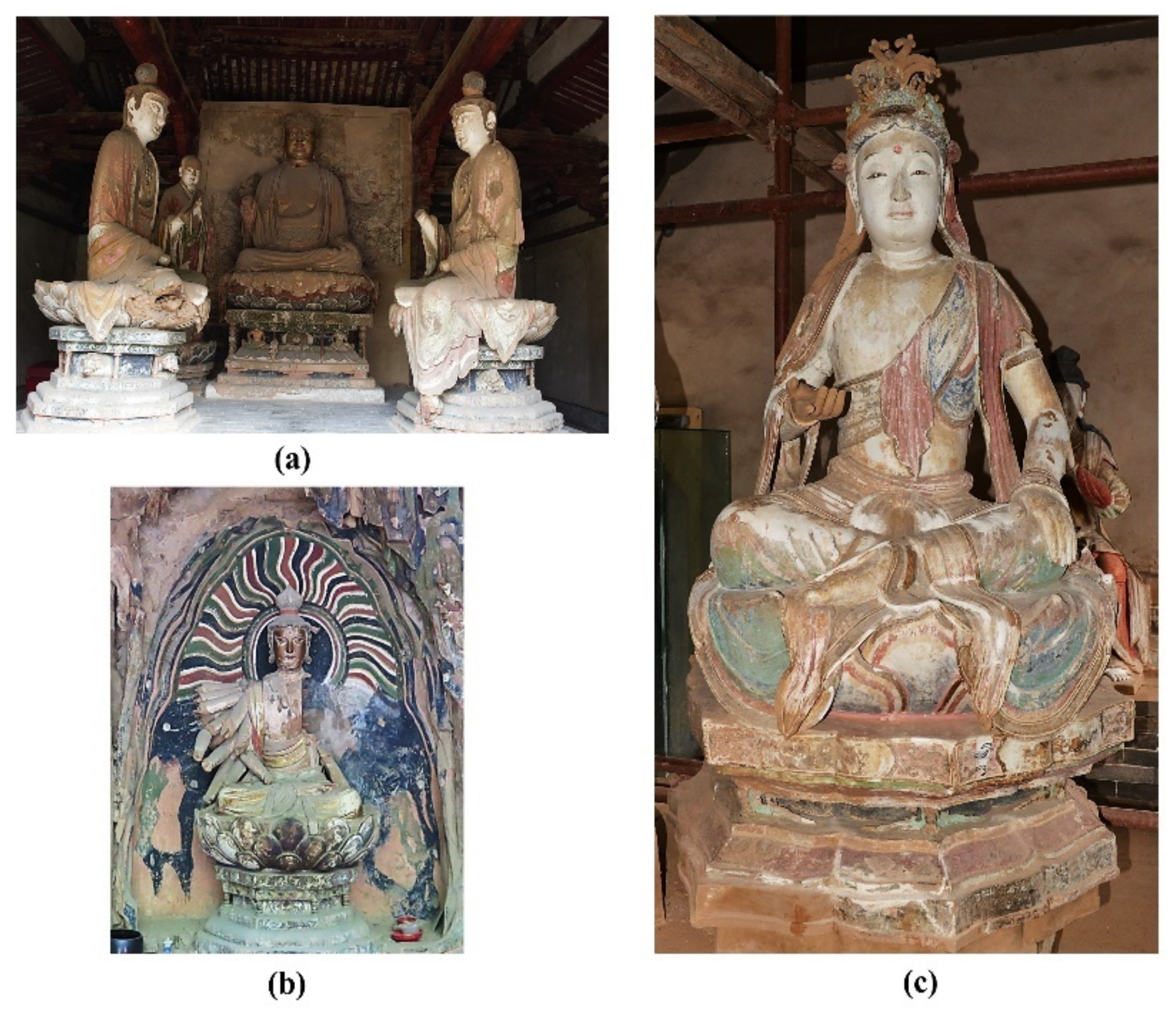
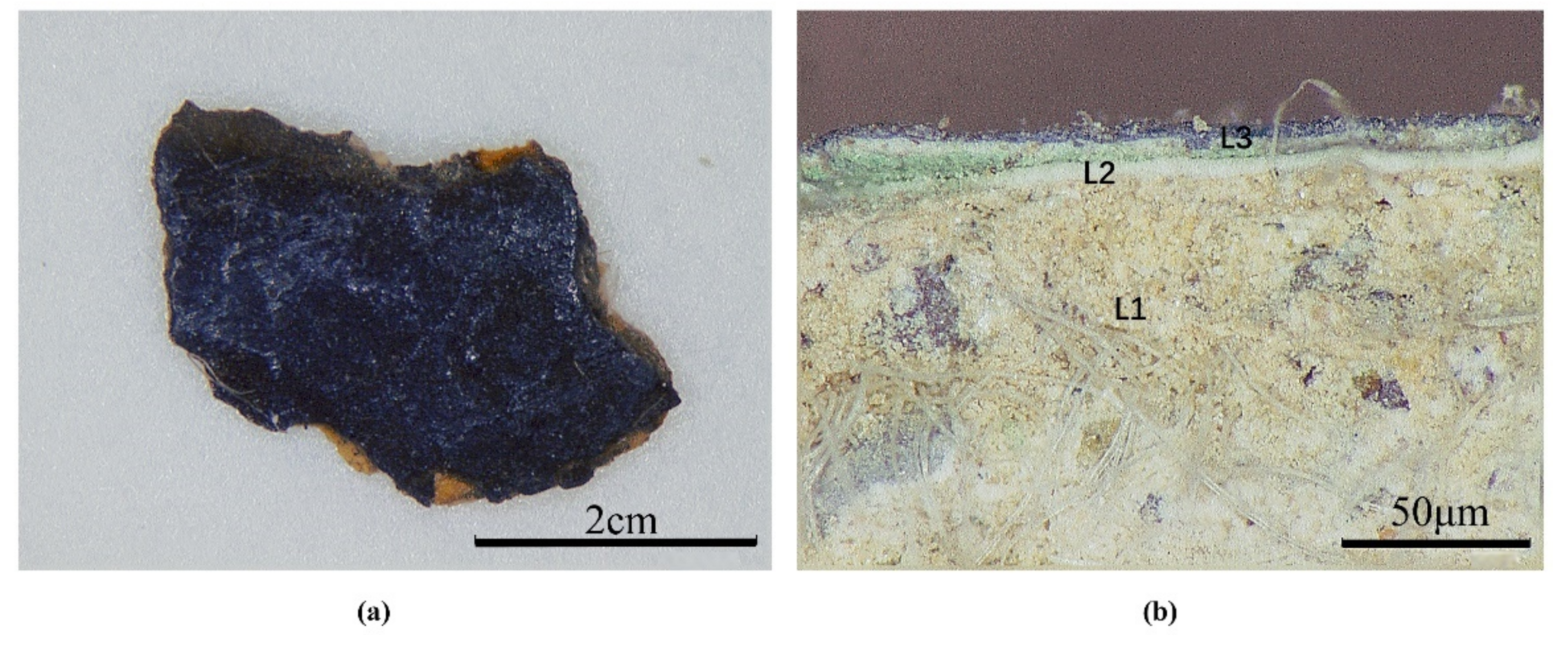
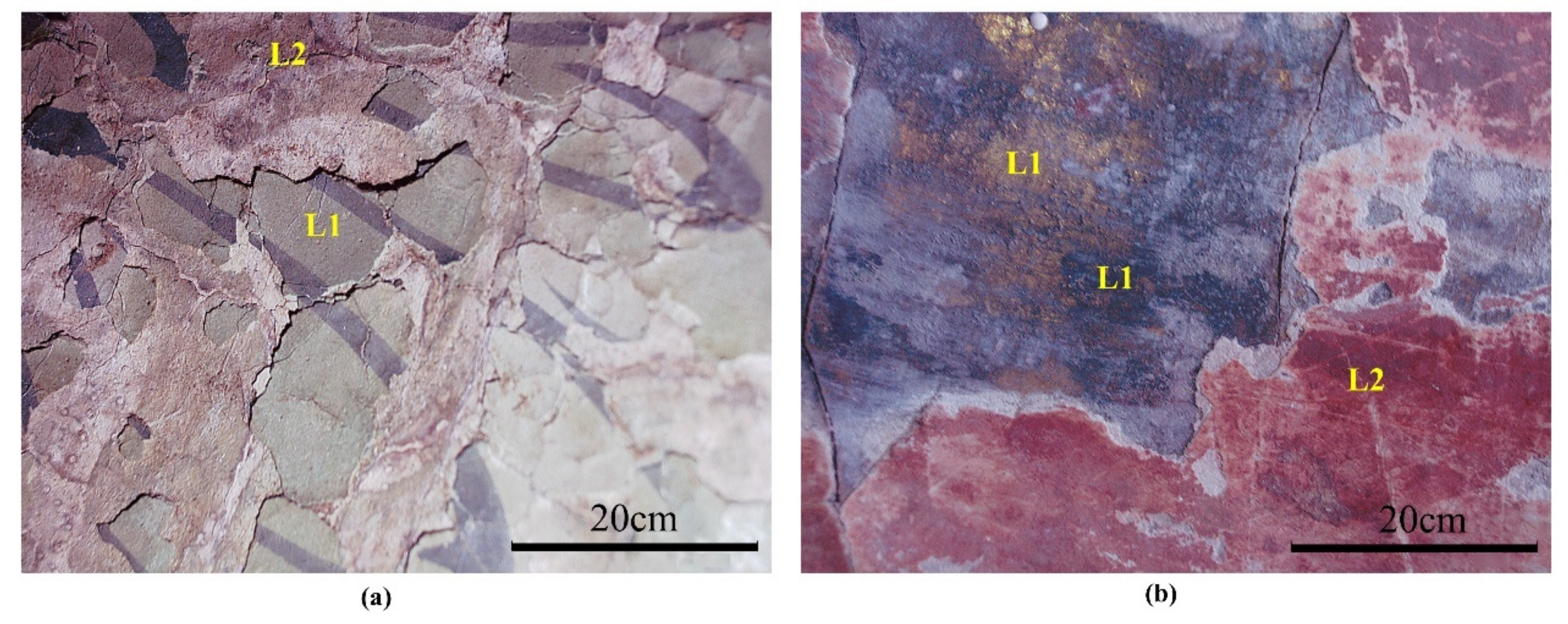
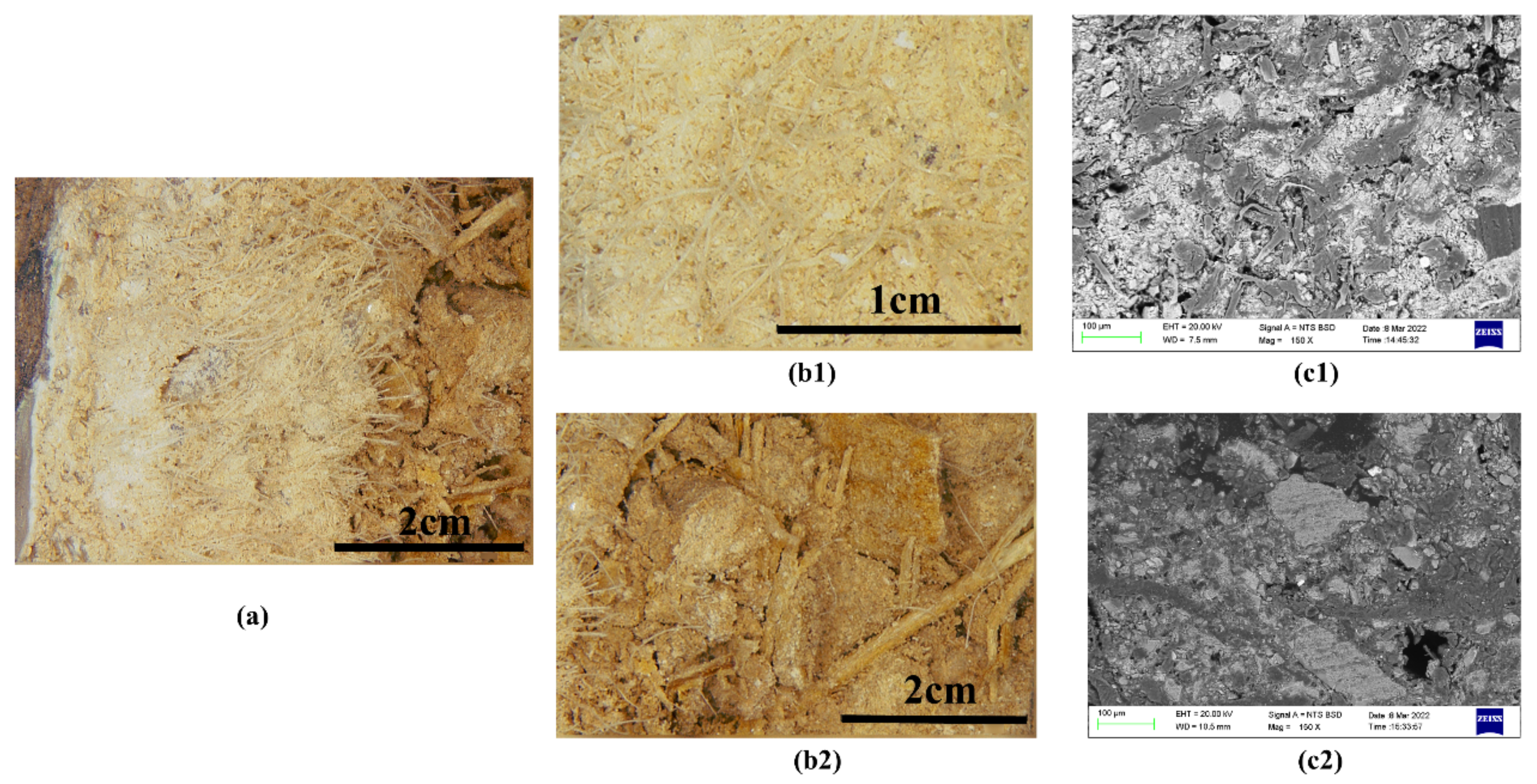
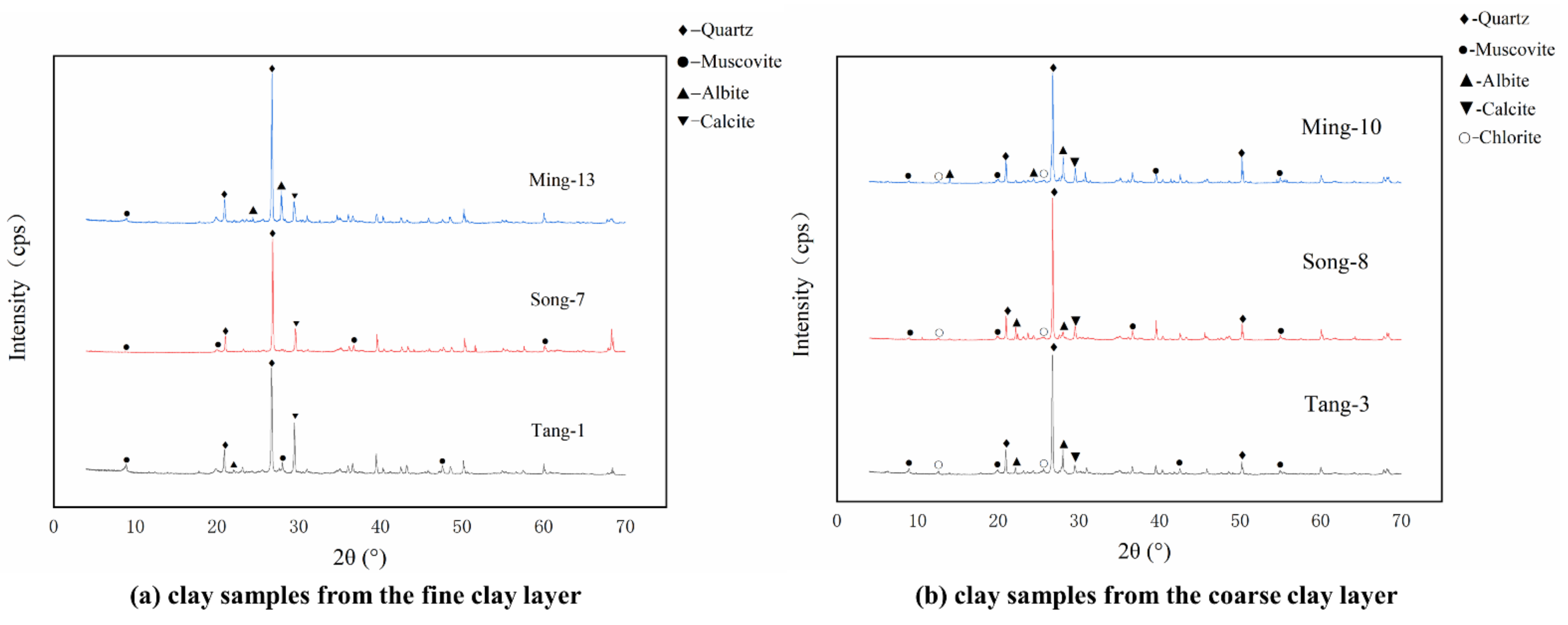

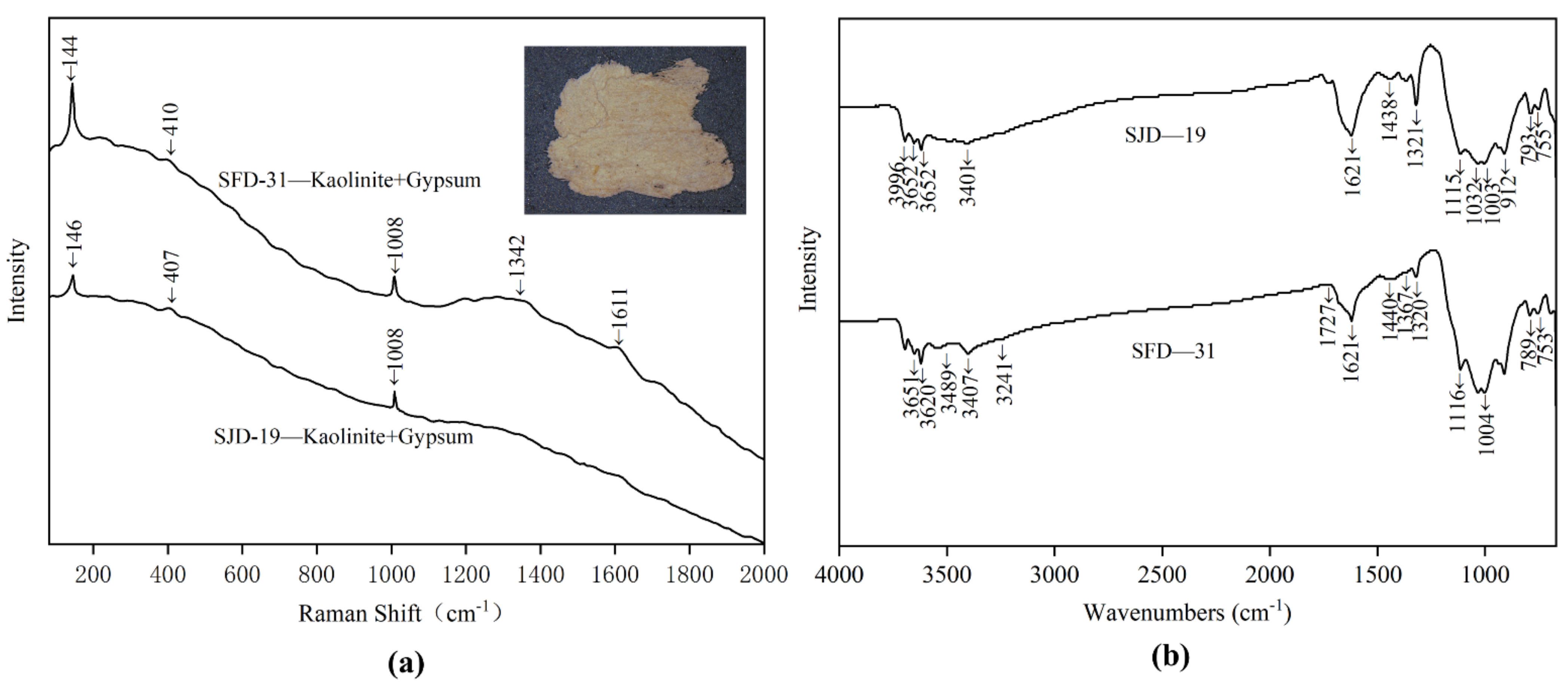
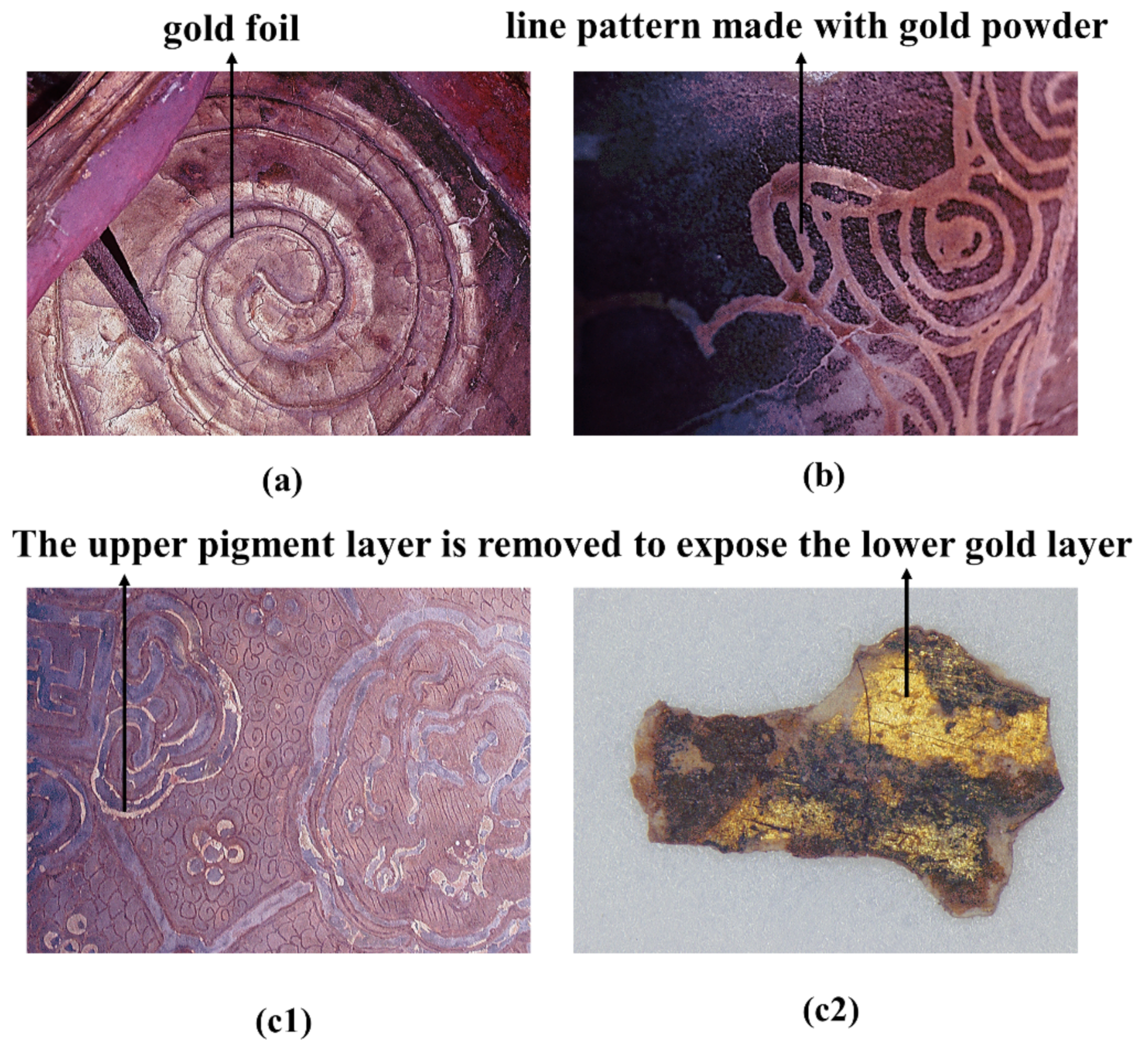
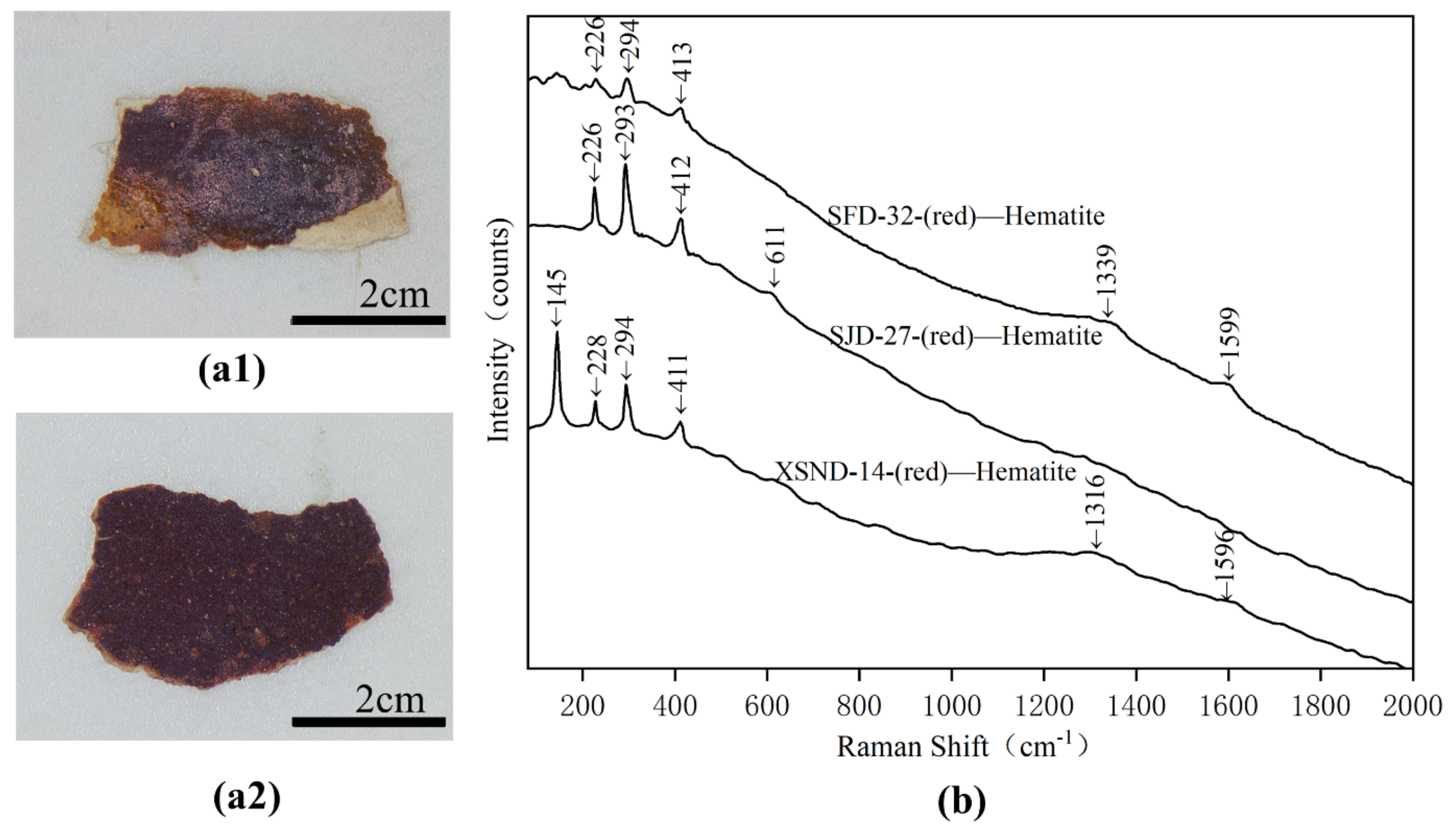
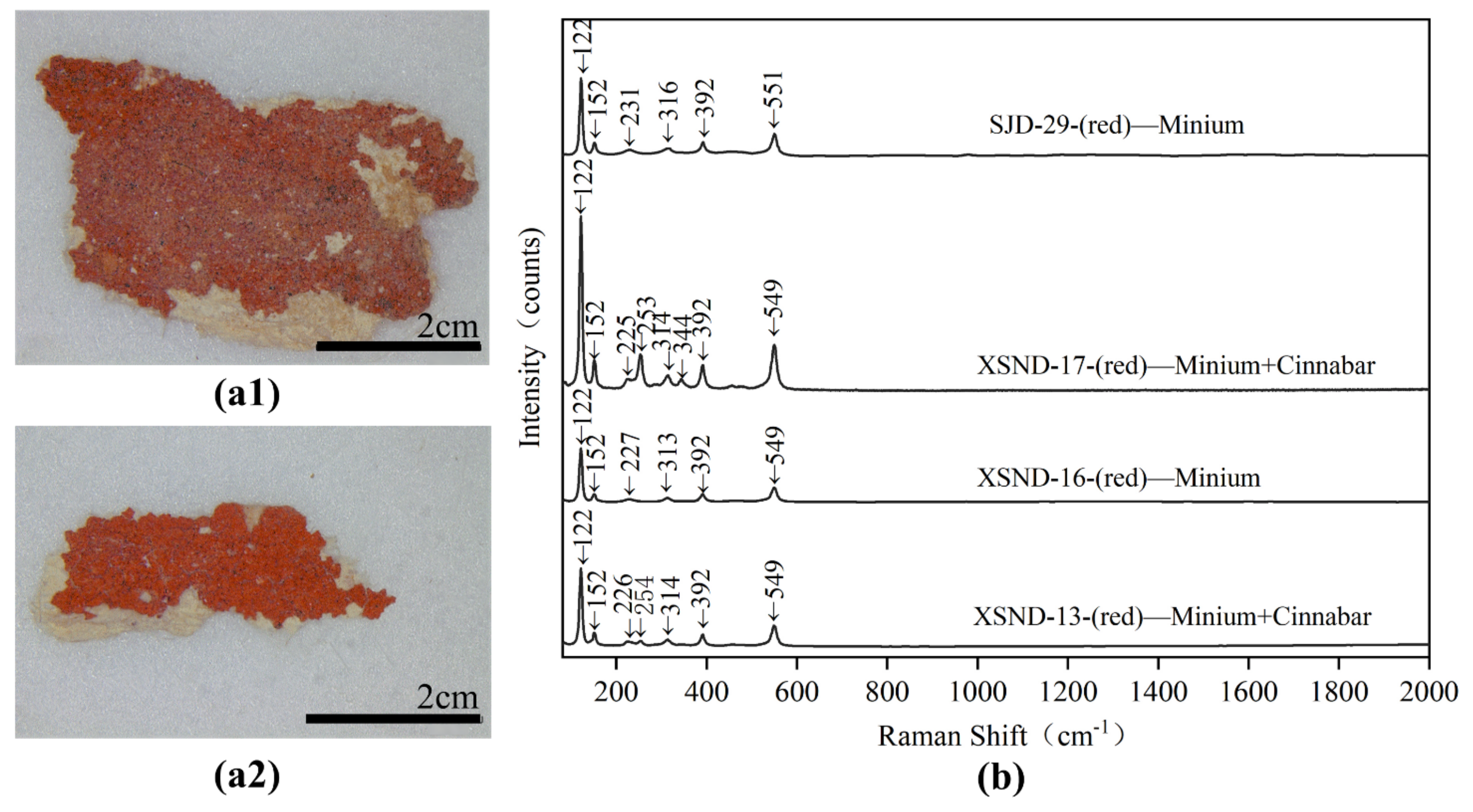
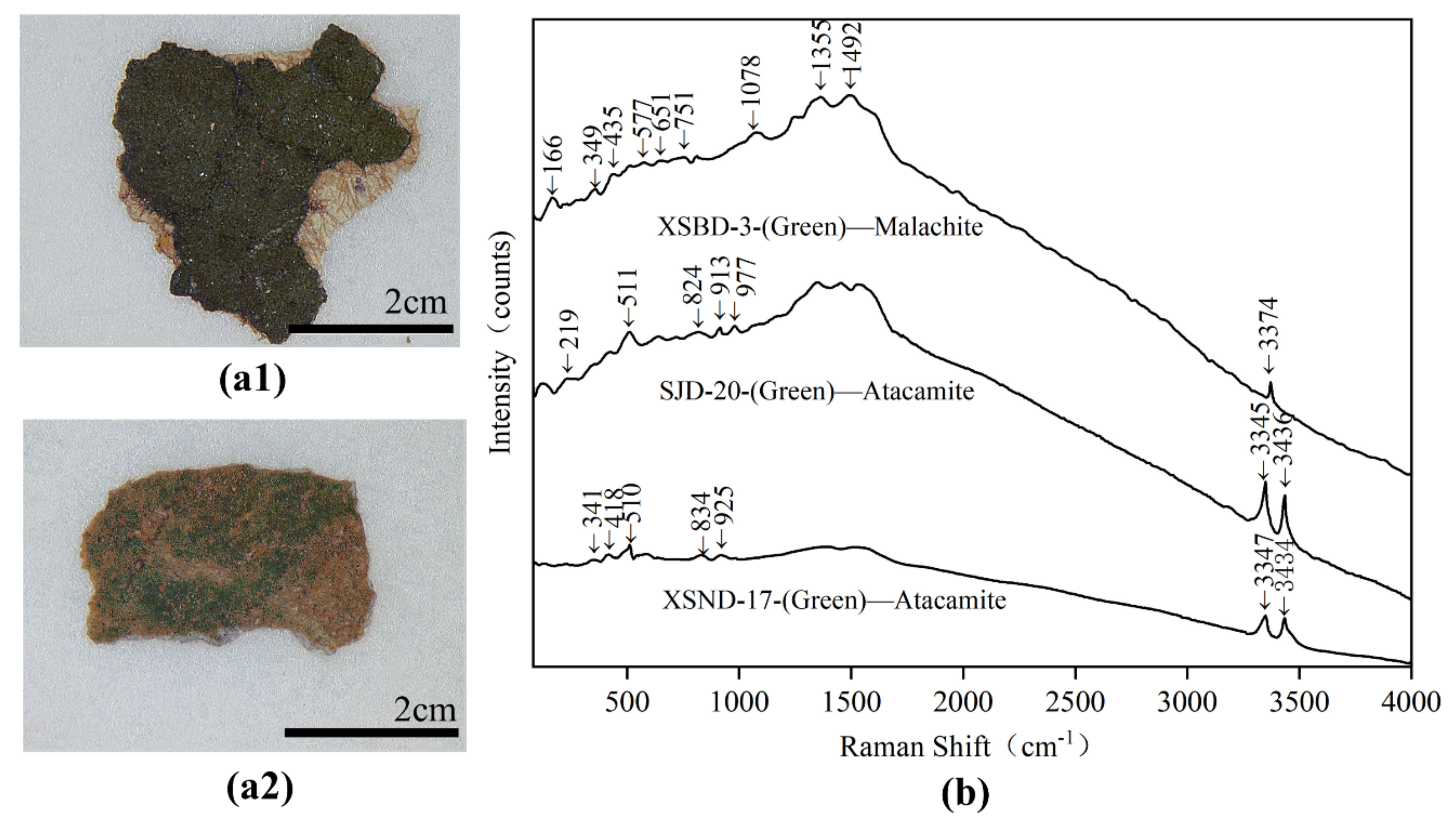



| Sample No. | Position | Sculpture | Mineral Composition by XRD |
|---|---|---|---|
| Tang-1 | fine clay layer | Bodhisattva Samantabhadra in XSBD (Tang dynasty) | quartz, muscovite, albite, calcite |
| Tang-2 | Bodhisattva Manjusri in XSBD (Tang dynasty) | quartz, muscovite, albite, calcite, chlorite | |
| Song-7 | Sakyamuni Buddha in XSND (Song dynasty) | quartz, muscovite, albite, calcite | |
| Song-9 | Bodhisattva Manjusri in XSND (Song dynasty) | quartz, muscovite, albite, calcite | |
| Song-11 | Bodhisattva Manjusri in XSND (Song dynasty) | quartz, muscovite, albite, calcite | |
| Ming-12 | Sakyamuni Buddha in SFD (Ming dynasty) | quartz, muscovite, albite, calcite, chlorite | |
| Ming-13 | Sakyamuni Buddha in SFD (Ming dynasty) | quartz, muscovite, albite, calcite | |
| Tang-3 | coarse clay layer | Bodhisattva Manjusri in XSBD (Tang dynasty) | quartz, muscovite, albite, calcite, chlorite |
| Tang-4 | Bodhisattva Samantabhadra in XSBD (Tang dynasty) | quartz, muscovite, albite, calcite | |
| Song-6 | Sakyamuni Buddha in XSND (Song dynasty) | quartz, muscovite, albite, calcite, chlorite | |
| Song-8 | Bodhisattva Manjusri in XSND (Song dynasty) | quartz, muscovite, albite, calcite, chlorite | |
| Ming-10 | Sakyamuni Buddha in SFD (Ming dynasty) | quartz, muscovite, albite, calcite, chlorite |
| Sample No. | Position | Sculpture | Morphological Characteristics of Fibres | Fibre Identification |
|---|---|---|---|---|
| XSBD-F1 | fine clay layer | Bodhisattva Samantabhadra in XSBD (Tang dynasty) | The single fibre is long (compared to wheat or rice straws) and shows uneven thickness along its length direction. There are obvious transverse knots, cell cavities and longitudinal stripes on the fibre wall. | Ramie |
| XSBD-F2 | Bodhisattva Manjusri in XSBD (Tang dynasty) | The fibres are long (compared to wheat or rice straw) and appears in a dark wine red after staining. There are obvious transverse nodal lines on the fibre wall, and the diameter of the cell cavity is small, while the cavity itself is uneven. Both ends of the fibres are pointed, and the cell wall of the parenchyma cell is very thin, showing deformation and bending. Some translucent membranous tissue was found to connect with the parenchyma cells. | Kenaf | |
| XSND-F4 | Sakyamuni Buddha in XSND (Song dynasty) | The fibre is cylindrical and shows as a dark wine red after dyeing. The fibre shows uneven thickness along the length direction and has relatively thick cell walls. Fine transverse nodal lines are found on the cell wall. | Sisal hemp | |
| XSND-F5 | Bodhisattva Manjusri in XSND (Song dynasty) | The fibres are long and thin, showing a twisted shape. Its fibre wall is smooth without any knots or pits. Obvious cell cavities are visible, and the fibre appears wine red after dyeing. | Cotton | |
| XSBD-F3 | coarse clay layer | Bodhisattva Manjusri in XSBD (Tang dynasty) | The fibre is short, with sparse transverse knots. The cell cavity is obvious. Both ends of the fibre are blunt, with divergent or spherical ends. The fibre shows as blue purple after dyeing. | Green sandalwood bark |
| Sample No. | Name of Buddha | Colour | Main Elements (SEM-EDS) | Raman Bands (cm−1) | Pigment |
|---|---|---|---|---|---|
| SFD-33 | Sakyamuni Buddha | Gold | Au, Ag, Pb, Cu, Fe, C, O | / | Gold (Au) |
| SJD-26 | Ananda | Au, Ag, Pb, Cu, C, O | / | Gold (Au) | |
| XSND-16 | Bodhisattva Manjusri | Red | Pb, O, Si, Al, C, Ca, Fe | 122(VS), 152(W), 227(W), 313(S), 392(S), 549(S) | Minium (Pb3O4) |
| SJD-29 | Ananda | Pb, O, Si, Al, C, Ca | 122(VS), 152(S), 231(W), 316(W), 392(S), 551(S) | Minium (Pb3O4) | |
| XSND-17 | Bodhisattva Manjusri | S, Hg, Pb, O, Ca, C, Si, Al, K, Fe | 122(VS), 152(S), 225(W), 253(S), 314(S), 344(W), 392(S), 549(S) | Minium(Pb3O4) + Cinnabar(HgS) | |
| XSND-13 | Bodhisattva Manjusri | S, Hg, Pb, O, Ca, C, Cl, Si, Al, K, Fe | 122(VS), 152(S), 226(W), 254(W), 314(W), 392(S), 549(S) | Minium(Pb3O4) + Cinnabar(HgS) | |
| XSND-14 | Sakyamuni Buddha | Fe, C, O, Si, Al, Ca, K | 145(VS), 228(S), 294(S), 411(S), 1316(W), 1596(W) | Hematite (Fe2O3) | |
| SJD-27 | Sakyamuni Buddha | Fe, C, O, Si, Al, Ca | 226(S), 293(VS), 412(S), 611(W) | Hematite (Fe2O3) | |
| SFD-32 | Sakyamuni Buddha | Fe, C, O, Si, Al, Ca, Cl | 226(W), 294(S), 413(W), 1339(W), 1559(W) | Hematite (Fe2O3) | |
| XSND-17 | Bodhisattva Manjusri | Green | Cu, Cl, C, O, Si, Al, Ca, K | 341(W), 418(S), 510(S), 834(W), 925(W), 3347(VS), 3434(VS) | Atacamite (Cu2(OH)3Cl) |
| SJD-20 | Sakyamuni Buddha | Cu, Cl, C, O, Si, Al, Ca, Fe | 219(S), 511(S), 824(W), 913(S), 977(S), 3345(VS), 3436(VS) | Atacamite (Cu2(OH)3Cl) | |
| XSBD-3 | Bodhisattva Manjusri | Cu, C, O, Si, Al, Ca | 166(S), 349(S) 435(S), 577(W), 651(W), 751(W), 1078(S), 1355(S), 1492(S), 3374(S) | Malachite (Cu2(OH)2CO3) | |
| SJD-24 | Sakyamuni Buddha | Blue | Cu, C, O, Si, Al, Ca | 253(S), 397(VS), 774(S), 839(S), 1355(S), 1589(S), 3430(S) | Azurite (Cu3(CO3)2(OH)2) |
| XSBD-4 | Ananda | Yellow | Fe, C, O, Ca, S, Si, Al, K | 144(VS), 247(S), 303(VS), 342(S), 393(VS) | Yellow ochre (FeO (OH)·nH2O) |
| SJD-22 | Ananda | Black | C, O, Si, Al, Ca | 1329(S), 1599(S) | Amorphous carbon (C) |
| XSBD-5 | Maitreya buddha | C, O, Si, Al, Ca | 1307(S), 1576(S) | Amorphous carbon (C) | |
| XSBD-1 | Bodhisattva Samantabhadr | White | Ti, C, O, Si, Al | 146(VS), 400(S), 518(S), 641(S) | Titanium white (TiO2) |
| XSBD-2 | Bodhisattva Manjusri | Si, Al, Ca, K, C, O | 142(S), 404(S), 462(W), 1009(S) | Kaolinite+Gypsum (Ca(SO4)·(H2O)2) | |
| XSBD-6 | Bodhisattva Manjusri | Si, Al, Ca, K, C, O | 143(S), 300(W), 403(W), 466(W), 1007(W) | Kaolinite+Gypsum (Ca(SO4)·(H2O)2) |
Publisher’s Note: MDPI stays neutral with regard to jurisdictional claims in published maps and institutional affiliations. |
© 2022 by the authors. Licensee MDPI, Basel, Switzerland. This article is an open access article distributed under the terms and conditions of the Creative Commons Attribution (CC BY) license (https://creativecommons.org/licenses/by/4.0/).
Share and Cite
Shen, J.; Li, L.; Zhang, D.; Dong, S.; Xiang, J.; Xu, N. A Multi-Analytical Approach to Investigate the Polychrome Clay Sculpture in Qinglian Temple of Jincheng, China. Materials 2022, 15, 5470. https://doi.org/10.3390/ma15165470
Shen J, Li L, Zhang D, Dong S, Xiang J, Xu N. A Multi-Analytical Approach to Investigate the Polychrome Clay Sculpture in Qinglian Temple of Jincheng, China. Materials. 2022; 15(16):5470. https://doi.org/10.3390/ma15165470
Chicago/Turabian StyleShen, Jingyi, Li Li, Dandan Zhang, Shaohua Dong, Jiankai Xiang, and Nuo Xu. 2022. "A Multi-Analytical Approach to Investigate the Polychrome Clay Sculpture in Qinglian Temple of Jincheng, China" Materials 15, no. 16: 5470. https://doi.org/10.3390/ma15165470
APA StyleShen, J., Li, L., Zhang, D., Dong, S., Xiang, J., & Xu, N. (2022). A Multi-Analytical Approach to Investigate the Polychrome Clay Sculpture in Qinglian Temple of Jincheng, China. Materials, 15(16), 5470. https://doi.org/10.3390/ma15165470





